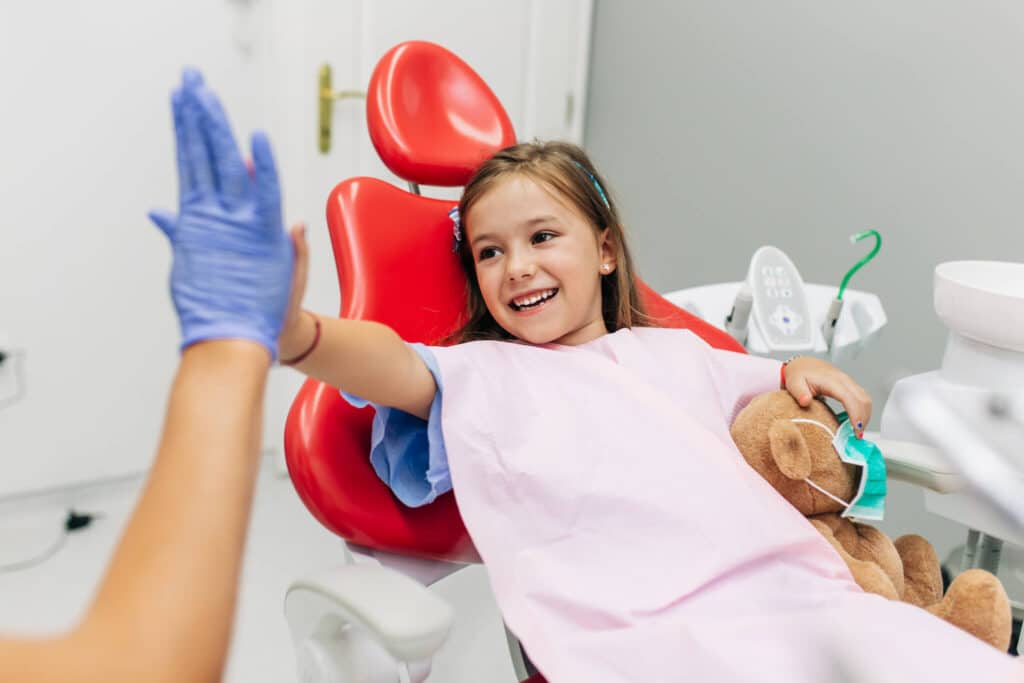“Does my child have a cavity?” “How can I tell?” “What do cavities look like in toddlers?” The pediatric dentists at Kangaroo Smiles Pediatric Dentistry receive questions like these all the time. And, it’s not surprising why. Tooth decay is the most common chronic childhood condition in the US. Why? The culprit is typically a combination of high levels of bacteria and excessive consumption of sugars and starches. Add on a lack of fluoride, and you have a recipe for cavities.
Every day, Dr. Mona Beylin and the Kangaroo Smiles team aim to provide compassionate parents and caregivers like you with accurate information about oral hygiene for children.
Below, you will learn how to tell if your child has a cavity, as well as treatments available for little ones.
Children’s Cavities: Know the Signs
Tooth decay varies from child to child. Some children don’t present any symptoms at all. Others, however, may exhibit some of the following symptoms:
Pain and Discomfort
Pain and discomfort in the tooth are often associated with the development of a cavity.
- Sensitivity to Hot or Cold Foods
Tooth sensitivity to particular foods is another common symptom. Take specific notice when your child eats something sweet or sips a hot or cold drink, as this can indicate the formation or presence of a cavity.
- Spots on the Teeth
Visible white spots on the teeth are an indication that the enamel of the tooth is beginning to break down.
- Color Changes
A light brown color indicates the early development of a cavity, while a darker shade means the cavity has already deepened. In either case, call your dentist immediately if you see this.
The only surefire way of knowing if your child has a cavity is to see pediatric dentistry in Lowell for a cleaning and evaluation.
How to Treat Cavities in Baby Teeth
“But, if my child has a cavity on her/his baby tooth, it’ll simply fall out and we’ll be done with it, right?”
Not exactly. Ignoring a cavity on a baby tooth can lead to long-term problems. Cavities can grow and largen. If that happens, your child might need a therapeutic pulpotomy as treatment. The infection of primary teeth can cause problems for permanent teeth, so they should always be addressed head-on.
So, how are baby teeth cavities treated? At Kangaroo Smiles, Dr. Mona numb the area around the infected tooth, so your child won’t experience any pain. Then, they remove the tooth decay before applying a naturally-white filling. If needed, nitrous oxide or “laughing gas” is available to ease the child’s treatment anxiety.
An alternative to filling cavities in baby teeth is remineralization. This option is offered when the cavity is small and growth can be stopped and even reversed. Remineralization strengthens enamel, so the tooth can later fall out naturally. Ask Dr. Mona or Dr. Simon more about this process at your child’s next appointment.
If Your Child Does Have a Cavity, Choose Kangaroo Smiles for Care!
Coming to the dentist doesn’t have to be scary. In fact, we make visiting Kangaroo Smiles as comfortable and positive as possible! We offer two child-friendly offices with vibrant, illustrations on the walls, in addition to upbeat, fun, and compassionate staff members.
We value educating little ones about awesome dental hygiene habits while making them feel safe and relaxed. If your child does have a cavity, either Dr. Mona or Dr. Guevarra Jean will explain the treatment process step-by-step. It’s equally important that our parents and caregivers feel fully informed and at ease.
Give your child the best pediatric dental care available today! For more information or to schedule an appointment, call our office at 978-425-1496.


 Pain and Discomfort
Pain and Discomfort